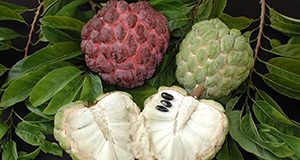Abstract
Because of the growing interest in alternative tropical fruit crops to diversify farm income, this 6-page fact sheet written by Fredy H. Ballen, Aditya Singh, Edward Evans, and Jonathan Crane and published by the UF/IFAS Food and Resource Economics Department offers an estimate of costs and returns associated with operating an established sugar apple orchard in south Florida.
http://edis.ifas.ufl.edu/fe1053
References
Bowman, K. D. 2015. Sugar apple emerges as tempting treat for Florida grower. Growing produce. http://www.growingproduce.com/fruits/sugar-apple-emerges-as-tempting-treat-for-florida-growers/
Crane, J. H., M. Aerts, and A. M. Mossler. 2002. Crop Profile for Atemoya and Sugar apple in Florida. https://ipmdata.ipmcenters.org/documents/cropprofiles/FLatemoyaandsugarapple2009.pdf
Crane, J. H., C. F. Balerdi, and I. Maguire. 2016. Sugar apple growing in the Florida Home Landscape. EDIS# HS38. Gainesville: University of Florida Institute of Food and Agricultural Sciences. http://edis.ifas.ufl.edu/mg330
Morton, J. 1987. "Sugar apple." In Fruits of Warm Climates. Published by Julia Morton, Miami FL. https://hort.purdue.edu/newcrop/morton/sugar_apple.html
USDA AMS. 2017. Agricultural marketing service. https://www.marketnews.usda.gov/mnp/fv-report-config-step1?type=termPrice
Unless otherwise specified, articles published in the EDIS journal after January 1, 2024 are licensed under a Creative Commons Attribution-NonCommercial-NoDerivs 4.0 International (CC BY-NC-ND 4.0) license.


